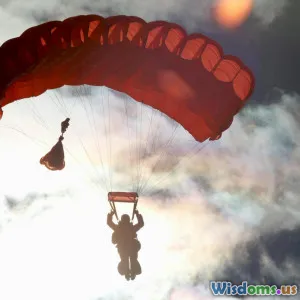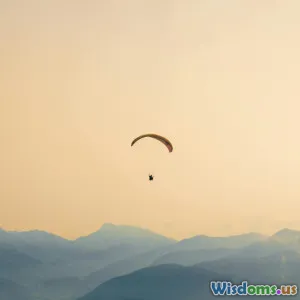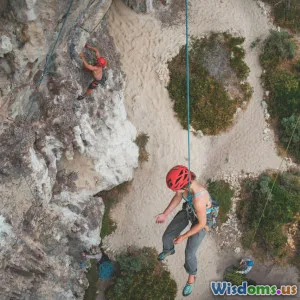
How to Choose the Best Skydiving Destinations Safely
9 min read Discover how to select thrilling yet safe skydiving destinations worldwide with expert insights and practical safety tips. (0 Reviews)
How to Choose the Best Skydiving Destinations Safely
Introduction
Imagine hurtling through the sky at 120 miles per hour, the wind buffeting your body, and breathtaking landscapes stretching below—the epitome of thrill and freedom. Skydiving isn’t just a sport; it’s a union of adrenaline and awe. But amid the excitement, safety remains paramount. Choosing the perfect skydiving destination isn’t simply about finding gorgeous views or exotic spots; it requires diligent research and a steadfast commitment to safety. This article explores how you can select the safest skydiving destinations that guarantee both unforgettable experiences and peace of mind.
Understanding Why Safety Matters in Skydiving Destinations
Skydiving inherently carries risks, many of which can be mitigated through proper equipment, training, and environment. According to the United States Parachute Association (USPA), skydiving's fatality rate in 2022 was approximately 0.28 per 100,000 jumps, reflecting rigorous safety improvements over decades. However, safety standards vary internationally.
Choosing a destination with strict regulatory oversight and experienced operators lowers risk. Poor weather, inadequate facilities, or poorly maintained equipment can turn thrill into tragedy. For example, the UAE has become a sought-after destination not only for its stunning desert and coastline views but also because its skydiving operators like Skydive Dubai adhere to strict international standards, offering one of the safest experiences.
Key Factors to Consider When Choosing a Skydiving Destination
1. Weather Patterns and Seasonal Considerations
Weather directly impacts safety and jump quality. Ideal skydiving conditions include clear skies, moderate wind speeds (generally below 15 mph), and stable atmospheric conditions.
Example: Interlaken, Switzerland, offers breathtaking mountain vistas; however, it experiences unpredictable alpine weather that can abruptly halt operations. Conversely, places like Perris Valley, California, provide over 300 days suitable for jumping annually, making it a preferred spot for consistent training and jumps.
Check destination climate data and ask local drop zones about peak times. Avoid seasons marked by monsoons or hurricane risks, such as in parts of Southeast Asia during the wet season.
2. Reputation and Certification of Drop Zones
Before booking, research the drop zone’s credentials:
- Are they affiliated with credible organizations like the USPA or the British Parachute Association?
- What's their safety record? Are there publicly accessible incident reports?
- Do they conduct regular equipment maintenance and ensure staff certification?
Drop zones with instructor experience exceeding thousands of jumps tend to manage risks better. For example, Skydive Empuriabrava in Spain, Europe's largest skydiving center, boasts comprehensive training and multiple safety accreditations, reflecting lower accident rates despite high jump volumes.
3. Equipment Standards and Modernity
Safety is often only as good as the gear used. Investigate whether the drop zone employs newer reserve parachutes, Automatic Activation Devices (AADs), and harness systems. AADs automatically deploy the parachute if a skydiver is incapacitated, significantly reducing fatalities.
Case in Point: The fatal incident rate dropped steeply after mandatory AAD usage was introduced in many countries. For instance, New Zealand requires every skydiver to use AAD, resulting in some of the safest skydiving conditions globally.
4. Training Quality and Jump Options
Reputable skydiving centers balance fun and safety through meticulous training programs.
- Are tandem jumps supervised by highly trained instructors?
- Is there a comprehensive overview of risks, safety protocols, and emergency procedures?
- Do they offer progressive training for solo jumps under certified instruction?
Clear, standardized training instills confidence and reduces panic-related errors.
5. Accessibility and Emergency Medical Services
Choosing destinations with proximity to advanced medical evacuation services and hospitals specializing in trauma care is prudent.
Remote drop zones may offer stunning views but can delay emergency response. For instance, skydiving centers in the Swiss Alps provide swift access to mountain rescue teams, whereas isolated island jumps might rely on limited resources.
6. Legal Environment and Regulatory Oversight
Countries with robust aviation and skydiving regulations maintain higher safety standards.
For example, Australia mandates strict licensing processes governed by the Australian Parachute Federation, ensuring operators meet stringent safety criteria. Conversely, unregulated zones may lack safeguards, making them riskier.
Examples of Top Safe Skydiving Destinations
Skydive Dubai, UAE
Why it’s safe: Licensed operator, well-maintained equipment, meticulous weather monitoring
Experience: Iconic views of the Palm Jumeirah and Dubai skyline with exceptional customer service
Perris Valley, California, USA
Why it’s safe: Numerous annual jumps, stable weather, comprehensive instructor training
Experience: Known for training jumpers and accommodating beginners and pros alike
Skydive Empuriabrava, Spain
Why it’s safe: Europe’s largest drop zone, USPA affiliate, outstanding safety record
Experience: Mediterranean seaside vistas with highly experienced instructors
New Zealand Drop Zones
Why it's safe: National safety regulations, mandatory AAD use, quick medical access
Experience: Stunning natural landscapes from North to South Island, beloved by savvy skydivers
Tips for Researching and Booking Your Jump
- Read reviews: Platforms like DropZone.com and Skydive Magazine forums provide real customer feedback.
- Ask questions: Contact operators to inquire about safety protocols, failure rates, and emergency plans.
- Insurance: Ensure you have appropriate insurance covering extreme sports.
- Certifications: Verify instructors’ and facilities’ credentials.
- Avoid deals that seem too good to be true: In safety, quality rarely comes cheap.
Conclusion
Skydiving offers an unrivaled rush and breathtaking perspective on the world. However, selecting your skydiving destination is not just about chasing stunning sceneries but mastering how safety, expertise, and environment coalesce into a secure jump. Evaluate weather, credible certifications, equipment standards, and emergency preparedness before booking. Destinations like Skydive Dubai and Empuriabrava represent paradigms where excitement meets safety.
By applying these principles, you safeguard your skydiving adventure, reduce risks, and maximize exhilaration, proving that with the right choices, your leap into the sky can truly soar beyond imagination while keeping your wellbeing intact.
Remember: As legendary skydiver Felix Baumgartner put it, "You don’t have to be the fastest or the strongest… you have to be the smartest to survive in the sky."
Ready to plan your safe, thrilling skydive? Research wisely, and the skies will embrace you like never before.
Article references:
- United States Parachute Association Fatality Reports [USPA]
- Australian Parachute Federation Regulations
- Skydive Dubai Safety Guidelines
- DropZone.com user testimonials
- New Zealand Parachute Federation Reports
Rate the Post
User Reviews
Other posts in Adventure Sports Travel
Popular Posts


















